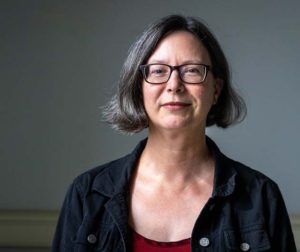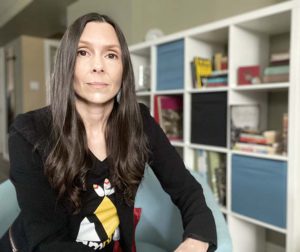Faculty from King’s School of Journalism have contributed to a set of guidelines [PDF] launched this week, for use by journalists reporting on missing Indigenous people. Assistant Professor Terra Tailleur and Rogers Chair in Journalism Trina Roache each participated in the guidelines initiative, which was led by a grassroots project called Looking Out For Each Other (LOFEO).
Described as “a community driven project,” LOFEO was started in 2015 by Wendy Wetteland and Elizabeth Blaney, both formerly of the New Brunswick Aboriginal Peoples’ Council (NBAPC) and former University of New Brunswick Faculty of Law professor Jula Hughes. LOFEO Project Manager Michelle Perley explains that the group was established “to ensure that our ‘Voices in the East'” would be included in the National Inquiry into Missing and Murdered Indigenous Women and Girls. LOFEO organized Sharing Circles with Indigenous community members and through this community engagement, the need for guidelines journalists could refer to when reporting on missing Indigenous people became clear.
“We heard that there is an uncertainty that exists when dealing with the media because people aren’t sure how their story will be portrayed or if it will even be reported on because they are Indigenous,” says Perley.
“This stems from the history of how mainstream media has depicted Indigenous people and the harm that it has caused.… We knew that education is needed in order for mainstream media to be more mindful of how they are reporting and that it needed to be responsive to the needs of missing Indigenous persons and their families.”
Terra Tailleur’s involvement began in 2019, when LOFEO asked if she would contribute her expertise to the development of the guidelines. Working with Erin Moore, a journalism instructor at the Nova Scotia Community College, Tailleur says that as they reviewed the research LOFEO had compiled, key themes emerged.

Assistant Professor of Journalism Terra Tailleur.
“A lot of it revolved around respect,” Tailleur says, “‘I want a reporter to treat me with respect, I want to be seen. And I don’t want anyone to fall into tropes and stereotypes.’ Tailleur says LOFEO provided them with a substantial amount of research, particularly focused on the experience of family members when a loved one goes missing. Tailleur and Moore conducted their own research into best practice guidelines for trauma-informed reporting and ethics guidelines, ultimately compiling a comprehensive list of resources.
“We were also thinking about our own experiences in newsrooms and what we know that reporters deal with … the realities of trying to meet constant and frequent deadlines.”
Recently published, the guidelines are divided into short sections, many of which outline questions journalists should ask themselves during different stages of the reporting process. These are further enhanced with several pages of online resources that discuss related topics in greater depth, from sources including the International Committee of the Red Cross, The Toronto Star, and the Canadian Association of Journalists.

Rogers Chair in Journalism Trina Roache.
Trina Roache says that she provided “a media perspective at different points in the development of the guidelines.” Roache became involved at the urging of Catherine Martin, the acclaimed filmmaker and producer who is Dalhousie University’s first Director of Indigenous Community Engagement and a member of King’s Board of Governors.
Roache considers the guidelines a valuable resource to anyone reporting on missing Indigenous people, including Indigenous reporters.
“As a Mi’kmaw journalist I understand how important it is to get the story right—to make sure that the details you’re including are appropriate, that you’re providing context in these kinds of stories. But I also understand that—as a Mi’kmaw journalist—I don’t inherently possess an ability to report responsibly or do trauma-informed reporting. Those are learned skills… it’s important for a set of guidelines to exist for everybody—not just for mainstream newsrooms.”
Roache points to the problem of Indigenous reporters being expected to provide non-Indigenous colleagues with advice on how to cover stories based in Indigenous communities.
“The onus can’t just be on an Indigenous person in an organization to know how to do this. You can’t just say ‘Well, the Indigenous reporter probably knows how to do this’—and the guidelines talk about this—you know, we have to take that burden away.”
Both Roache and Tailleur agree that it is crucial for information like this to be taught to students in journalism programs.
“If you can integrate this in general reporting practices it becomes part of the foundation of learning,” says Tailleur, “and hopefully it will stick with them—these concepts of trust and respect. And … hopefully they can weave that in and build that into other reporting assignments that they do.”
“You know,” Roache says, “the TRC [Truth and Reconciliation Commission] has called on journalism schools to do this kind of work, and to make sure that we are providing history, context and cultural information to journalists, so it’s a call of the TRC and it’s really important to do it now.”
“We’re teaching journalism students everything else,” Roache says with a laugh. “We’re teaching them fairness and balance and independence. Well one of those things has to be that we represent Indigenous people in a responsible way—and especially when someone goes missing and there’s a crisis.”
Tailleur and Roache began incorporating the guidelines into their teaching in the spring when they co-taught the course Reporting in Mi’kma’ki.
“That was super-useful because we got a sense from students of what reporters would think and would consider if they were out in the field,” Tailleur says.
Expanding this initiative, Tailleur and Moore have developed a class module designed for use by journalism schools across Canada that will launch this fall. In what they hope will be a future phase of this project, they are also working on a set of guidelines to help the families of missing Indigenous people navigate media interactions.
“I can help the team figure out how to reach journalists and how to reach journalism students and LOFEO knows how to reach communities,” Tailleur says. “And I think this is where the magic really happens: when people come in and they work to their strengths and they support each other.”

